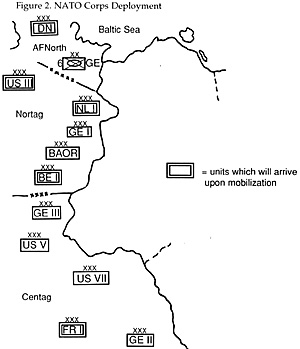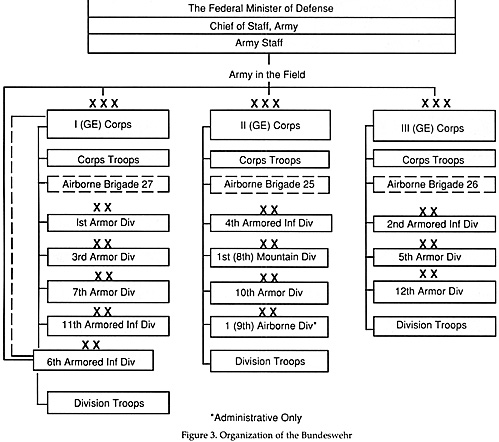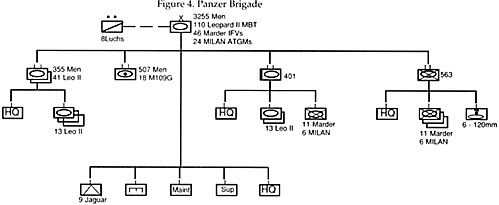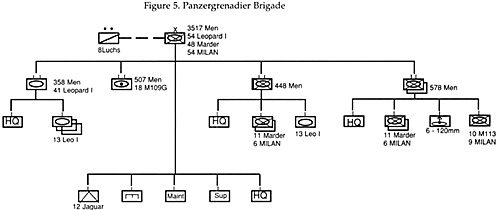 To participate in the common defense of Western Europe, the
FRG established the Bundeswehr (German Armed Forces). Together
with its NATO Allies, the Bundeswehr is charged with preventing an
armed attack on Federal territory. Some major restrictions were
placed on the Bundeswehr when it was established. The main
portion of the fighting troops would fight under NATO commanders
during wartime. The FRG cannot possess strategic, nuclear, chemical,
or biological weapons. However, the NATO Allies have such
weapons within the country and the West Germans have some say in
their use. There is no General Staff for operational control of the
Bundeswehr. And the logistics support is strictly limited to within
the country itself.
To participate in the common defense of Western Europe, the
FRG established the Bundeswehr (German Armed Forces). Together
with its NATO Allies, the Bundeswehr is charged with preventing an
armed attack on Federal territory. Some major restrictions were
placed on the Bundeswehr when it was established. The main
portion of the fighting troops would fight under NATO commanders
during wartime. The FRG cannot possess strategic, nuclear, chemical,
or biological weapons. However, the NATO Allies have such
weapons within the country and the West Germans have some say in
their use. There is no General Staff for operational control of the
Bundeswehr. And the logistics support is strictly limited to within
the country itself.
The German Basic Law expressly prohibits preparation for or waging of aggressive war. In short, the Bundeswehr is intended to be an integral part of a multi-national defense effort under NATO command rather than an independent military force. (see Figure 2.)
With this mission in mind, the Bundeswehr has been organized into two separate entities, the Field Army and the Territorial Army. Each has its own distinct task within the broad outline of the defense mission. The Field Army, under the operational command of NATO, will conduct operations in the forward defense zone in its allocated corps sectors. The Territorial Army, under national command, will be responsible for assuring the freedom of maneuver of all NATO forces within Germany and will provide personnel and material replacements to the Field Army.
 The Field Army forms the major combat force of the
Bundeswehr. Organized into three Corps and 11 combat divisions, as
shown in Figure 3, the Field Army is composed of 36 brigades: 17
armored; 15 mechanized infantry; one mountain; and three airborne.
This composition creates a force that is primarily armored combat
troops.
The Field Army forms the major combat force of the
Bundeswehr. Organized into three Corps and 11 combat divisions, as
shown in Figure 3, the Field Army is composed of 36 brigades: 17
armored; 15 mechanized infantry; one mountain; and three airborne.
This composition creates a force that is primarily armored combat
troops.
The basic organization of the Field Army is the division. Each division has three combat brigades, an artillery regiment, an air defense regiment, an armored reconnaissance battalion, and various support elements. The heavy brigades (armor and mechanized) have three combat battalions of four line companies each. This changes under wartime mobilization. Two light infantry battalions, armed with mortars and antitank weapons, will be available within three days and will be attached to each division. These are air mobile- capable although normally they will use truck transport. Each heavy brigade will form an additional 'mixed' combat battalion headquarters and will crossattach companies from the other battalions in the brigade.
Brigade Base Concept
Contrary to United States doctrine and organization where battalions are attached to brigades as dictated by the mission to be performed, the Bundeswehr uses a Brigade Base concept. Each brigade is a separate entity and will fight as such. While task organizations within the brigade is expected, battalions will not normally be shifted between brigades. Each brigade has its own reconnaissance, engineers, tank destroyers, supply and maintenance units, as well as its own artillery battalion. This artillery is dedicated to the brigade - a contrast to the U.S. system where all artillery assets are controlled at the division level.
 The organization of a typical panzer (armored) brigade is
shown in Figure 4. The unit is a combined arms force. The primary
punch of the brigade are its two panzer battalions, each containing 41
Leopard II main battle tanks (MBTs). A fully mechanized infantry
battalion, mounted on Marder infantry fighting vehicles (IFVs),
provides the needed support. The mixed battalion added upon
mobilization is the brigade in miniature: two tank companies of 13
MBTs and one Marder-mounted infantry company.
The organization of a typical panzer (armored) brigade is
shown in Figure 4. The unit is a combined arms force. The primary
punch of the brigade are its two panzer battalions, each containing 41
Leopard II main battle tanks (MBTs). A fully mechanized infantry
battalion, mounted on Marder infantry fighting vehicles (IFVs),
provides the needed support. The mixed battalion added upon
mobilization is the brigade in miniature: two tank companies of 13
MBTs and one Marder-mounted infantry company.
In all, a panzer brigade fields 110 MBTs. The organic artillery battalion, consisting of 18 M-109 self-propelled 155mm howitzers, provides support for the whole brigade. Additional anti-tank capability comes from the nine Jaguar-1 vehicles, firing the long range HOT anti-tank guided missile (ATGM). Reconnaissance and screening is provided by the eight Luchs armored cars attached to the brigade headquarters.
 A panzergrenadier brigade is organized as shown in Figure 5,
and it is a mirrored image of the panzer brigade. There are two
mechanized infantry battalions and one panzer battalion making up
the parent unit. Both infantry battalions include two companies of
infantry mounted in Marder IFVs and one company mounted in
older M-113 personnel carriers. The panzer battalion has 41 less-
potent Leopard I's. The mixed battalion has two companies of
infantry and one company of Leopard I's. Artillery, anti-tank, and
reconnaissance support is identical to that of a panzer brigade.
A panzergrenadier brigade is organized as shown in Figure 5,
and it is a mirrored image of the panzer brigade. There are two
mechanized infantry battalions and one panzer battalion making up
the parent unit. Both infantry battalions include two companies of
infantry mounted in Marder IFVs and one company mounted in
older M-113 personnel carriers. The panzer battalion has 41 less-
potent Leopard I's. The mixed battalion has two companies of
infantry and one company of Leopard I's. Artillery, anti-tank, and
reconnaissance support is identical to that of a panzer brigade.
These two brigade types make up the bulk of the Field Army. Airborne and mountain brigades are basically non-mechanized infantry and used in specialized situations. One airborne brigade is assigned to each of the three corps as a mobile reserve. It is fully air- mobile and fields TOWs and 20mm automatic. cannon mounted on light vehicles.
Upon mobilization, an additional light parachute infantry battalion may be added to each brigade. The mountain brigade is trained and organized for independent alpine operations using conventional light infantry tactics. It has four combat battalions and a towed light artillery battalion. It is based near Munich in southern Germany.
Equipment
The main equipment of the Field Army is quite modern and potent. Its MBT, the Leopard II, is a state-of-the-art fighting vehicle. Powered by a 1500 horsepower diesel which gives it a maximum speed of 47 miles per hour, protected by Chobham armor, and armed with a 120mm main gun which gives it more punch than the current MI Abrams MBTs, the Leopard II provides the mobility and firepower needed to meet the Soviets head on. Currently the Bundeswehr has 1500 of these tanks in its arsenal, with some 300 more on order. They are replacing the smaller, lighter Leopard I's in the frontline panzer brigades, allowing the 2400 Leopard I's to be issued to the panzergrenadier units. For the infantry, the main vehicle is the Marder IFV. This vehicle is a high-powered squad vehicle, able to keep up with the Leopard 11's in speed and range. It can provide support for its eight infantrymen with a 25mm automatic gun and two machineguns. Its drawbacks are that it is non-amphibious and has no vehicle-mounted anti-tank capability.
By contrast, the M2 Bradleys of the U.S. Army carry TOW ATGMs to provide some extra punch. The German infantry's primary anti-tank weapon is the French Missile d'Infanterie Leger Anti-char (MILAN) ATGM, a wire-guided missile fired from a tripod with a range of 2000 meters. The U.S. TOW ATGM is also in service, particularly with the airborne brigades. It adds additional standoff capability to those lightly armed troops with its range of 3700 meters. If the Bundeswehr has a drawback in its arsenal, it's probably its helicopter units. The PAH-1 attack helicopter is not up to the protection and firepower standards of either the Cobra or the Apache. Armed with only six missiles, the fewest among NATO's helicopter arsenal, it can make use of the HOT missile's excellent 4000 meter range, but it may not last long in a hostile battlefield environment.
More Bundeswehr Mission, Organization, and Doctrine
Back to Table of Contents: CounterAttack #1
To CounterAttack List of Issues
To MagWeb Master Magazine List
© Copyright 1987 by Pacific Rim Publishing Company.
This article appears in MagWeb (Magazine Web) on the Internet World Wide Web.
Other military history articles and gaming articles are available at http://www.magweb.com